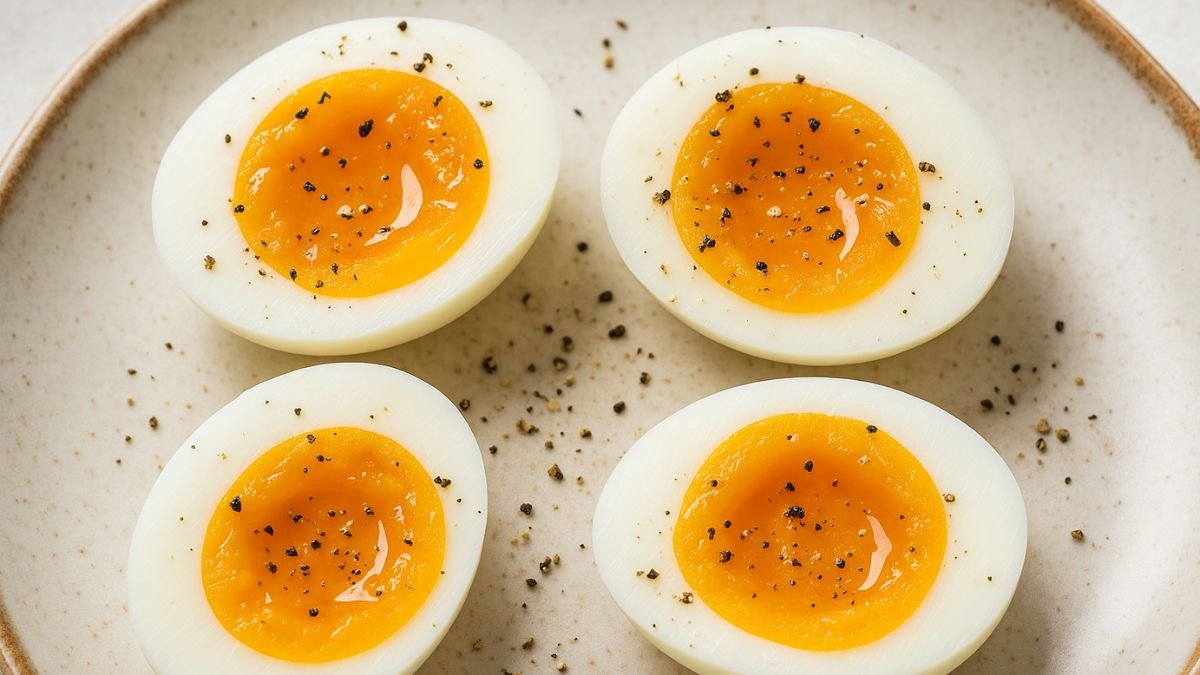FOOD
Jammy Eggs: Easy Guide to Creamy, Custard Yolks

What are Jammy Eggs?
A jammy egg is the sweet spot between hard-boiled and soft-boiled. The egg white is fully set, while the yolk is custard-like, spoonable, and jam-like in texture. Think of it as a creamy center with firm edges—ideal for slicing and savoring.
Why They’re Trending
From avocado toast on Instagram to ramen bars in trendy cafés, jammy eggs are everywhere. Their vibrant, bright orange yolk adds visual appeal, while their rich texture offers protein and satisfaction, making them a breakfast and brunch staple.
How to Make Perfect Jammy Eggs
Entities involved: boiling water, bowl, black pepper, blanch-shock, bright orange yolk
Ingredients:
-
Large eggs (room temperature or cold)
-
Water
-
Ice cubes
-
Salt, black pepper, optional toppings: furikake, chili crisp
Steps:
-
Fill a pot and bring boiling water to a rolling boil
-
Use a slotted spoon or bowl scoop to gently lower each egg into the pot.
-
Boil for 6½ to 7 minutes (6:30 for slightly runnier yolks; 7:00 for classic jammy texture).
-
Immediately plunge into an ice bath (blanch-shock) for 2–5 minutes to stop cooking and make peeling easier.
-
Crack gently at the wide end, peel under running water, and slice in half.
Pro Tips & Variations
-
Timer precision is essential: even 30 seconds alters texture.
-
Ice bath ensures easy peeling and yolk consistency.
-
For marinated ramen eggs, boil for ~6:30, cool 2 minutes, then soak in soy + mirin marinade.
-
Prefer steaming? Use a basket and steam 6–7 minutes for similar results.
Quick Cooking Time Guide
| Doneness | Cook Time | Yolk Texture |
|---|---|---|
| Soft-boiled/runny | 6 min | Very runny, ideal for dipping |
| Jammy egg | 6:30–7 min | Creamy, custard-like, spoonable |
| Slightly firm yolk | 7–8 min | Semi-solid but still rich |
| Hard-boiled | 10–12 min | Fully cooked yolk (no green ring) |
Best Ways to Use Jammy Eggs
-
Avocado toast: topper drizzled with olive oil and black pepper
-
Ramen/grain bowls: adds silkiness and protein
-
Salad topping: boosts flavor and texture
-
Breakfast boards: paired with veggies, cheese, bread
Common Mistakes to Avoid
-
Over-boiling → chalky yolk
-
Skipping ice bath → hard peel, continued cooking
-
Using too many eggs in small pot → water temp drops.
Jammy vs. Soft vs. Hard-Boiled
-
Soft: runny whites, very runny yolk
-
Jammy: fully set whites, creamy yolk
-
Hard: firm yolk, no risk of green ring
FAQ
Q: How long do jammy eggs take to cook?
A: About 6 minutes 30 seconds to 7 minutes in boiling water, then 2–5 minutes in an ice bath.
Q: Are jammy eggs safe?
A: Yes, as whites are fully set. Use clean, fresh eggs and proper boiling to eliminate surface bacteria.
Q: Can you prep jammy eggs in advance?
A: Yes—store peeled or unpeeled in fridge up to 3 days.
A: Whites are silky firm; yolk is rich, buttery, and spoonable—like a soft custard.
Q: Is a ramen egg same as a jammy egg?
A: A ramen egg (ajitsuke tamago) is a jammy egg marinated in soy, sake, and mirin—same base, extra flavor .
Conclusion
Jammy eggs combine visual beauty, delicious texture, and versatile use. With the right combination of boiling, timer precision, and ice bath, you get creamy yolks and white stability every time. Pair them with toast, salad, or ramen, and elevate your everyday dishes.

BLOG
Monster BFC Size Breakdown: Servings, Sugar, and Facts

If you’re an energy drink consumer, a student pulling an all-nighter, a fitness enthusiast chasing one more set, a truck driver on a long haul, or even a collector of rare Monster Energy cans—you’ve probably heard of the Monster BFC size. Known as one of Monster Energy’s biggest cans, this 32-ounce powerhouse became a legend in the beverage world.
But what exactly was the Monster BFC size? Why did it become so iconic, and why was it eventually discontinued? In this article, we’ll break down its dimensions, caffeine, calories, and comparisons to other Monster cans—while also diving into its history and collectibility.
What Was the Monster BFC Size?
The Monster BFC can stood out because it was 32 ounces (946 ml)—twice the size of the original 16 oz Monster. For many fans, it was the ultimate way to fuel long nights, tough workouts, or endless road trips.
- Ounces: 32 oz
- Milliliters: 946 ml
- Servings per can: 2–3 (though most fans finished it in one go)
BFC stood for “Big F**in’ Can,” a name that perfectly captured its oversized status.*
Monster BFC vs Regular Monster
Let’s compare the Monster BFC size to other Monster Energy cans to see why it was such a beast.
| Monster Can | Size (oz/ml) | Approx. Caffeine | Calories (per can) | Status |
|---|---|---|---|---|
| Regular Monster | 16 oz / 473 ml | 160 mg | ~210 | Active |
| Mega Monster | 24 oz / 710 ml | 240 mg | ~320 | Active |
| Monster BFC | 32 oz / 946 ml | 320 mg | ~400 | Discontinued |
| Monster Energy XXL | 24 oz (limited regions) | ~260 mg | ~350 | Rare |
This Monster BFC drink size comparison shows why it was legendary—it dwarfed the competition.
Nutrition Facts: What Was Inside the Monster BFC?
The Monster BFC calories and nutrition label reflected its massive volume.
- Calories: ~400 per can
- Sugar: ~108 grams
- Caffeine: ~320 mg
- Carbs: ~108 grams
- Servings per can: 2–3 (though few people saved it for later)
Compared to other Monster Energy 32 oz cans, it was one of the highest in both sugar and calories, making it a heavy hitter.
Why Was Monster BFC Discontinued?
Many fans still ask: “Why was Monster BFC discontinued?”
The main reasons include:
- Portion size concerns – 32 oz in one sitting pushed health recommendations.
- Retail logistics – Shelves weren’t designed for cans that big.
- Market demand – Most consumers preferred the 16 oz and 24 oz options.
Health experts also warned about the Monster BFC caffeine content per can, which exceeded safe daily limits for many people.
According to the FDA, 400 mg of caffeine per day is generally safe for healthy adults. A single Monster BFC had almost that much in one can (FDA, 2023).
Monster BFC Review: Taste and Size Explained
Despite its size, the Monster BFC can tasted just like the classic Monster Energy flavor—sweet, syrupy, and strong. Fans described it as:
- Convenient – No need to buy multiple cans.
- Overpowering – Too much sugar and caffeine for some.
- Legendary – A must-try for collectors and hardcore fans.
Many compared it to the Mega Monster (24 oz) and said the BFC was only for those who could handle it in one sitting.

Monster BFC vs Red Bull’s Largest Can
For perspective, let’s compare it with Monster’s biggest rival.
- Monster BFC: 32 oz (946 ml), 320 mg caffeine
- Red Bull Tallboy: 20 oz (591 ml), ~190 mg caffeine
Clearly, the Monster Energy BFC vs Red Bull largest can wasn’t even a contest—Monster BFC dominated in size, calories, and caffeine.
The History and Collectibility of Monster BFC
The history of Monster BFC is short but memorable. It was launched in the 2000s as an oversized novelty but quietly discontinued a few years later. Today, collectible Monster BFC cans are rare and often traded among fans online.
Some enthusiasts even create Monster BFC size charts comparing it to modern editions like the Mega Monster or Monster XXL.
Who Was the Monster BFC For?
The oversized can appealed to specific groups:
- Students & gamers – for marathon study or gaming sessions.
- Fitness & gym fans – looking for pre-workout energy.
- Truck drivers & shift workers – needing sustained alertness.
- Collectors – who wanted rare cans.
In short, it became a cult classic among Monster Energy’s biggest fans.
Expert Sources and References
- FDA – Caffeine safety guidelines (FDA.gov)
- Mayo Clinic – Safe daily caffeine limits (MayoClinic.org)
- Energy Drink Information Database – Historical data on discontinued Monster cans (Energydrinkarchive.net)
Conclusion
The Monster BFC size may be gone, but it remains one of the most legendary energy drinks ever released. At 32 ounces, it was larger, bolder, and more extreme than anything else on the market. While discontinued for health and practical reasons, its impact still resonates among fans, gamers, athletes, and collectors.
FAQ’s
How big is a Monster BFC can?
It was 32 ounces (946 ml), making it one of the largest energy drink cans ever produced.
Why was Monster BFC discontinued?
It was discontinued due to health concerns, poor shelf fit, and declining demand.
How many servings are in a Monster BFC?
The label suggested 2–3 servings, but most people drank it in one sitting.
How much sugar is in a Monster BFC?
About 108 grams of sugar, which is more than double the daily recommended limit.
Where can I buy Monster BFC energy drink today?
It is no longer sold in stores, but collectors’ markets sometimes offer empty cans or sealed editions.
Is Monster BFC bigger than other energy drinks?
Yes, it was bigger than Mega Monster, XXL, and Red Bull’s largest can.
FOOD
Hajie Tunkara Chef: Redefining African Cuisine

Hajie Tunkara Chef Whether you’re a home cook, a restaurant owner, or just someone who loves a good food story, you’ll find inspiration and practical insights here
Who Is Hajie Tunkara Chef? The Story Behind the Name
Hajie Tunkara Chef isn’t just a culinary professional—he’s a storyteller, innovator, and cultural ambassador. Born in The Gambia and raised in a family where food was the heart of every gathering, Hajie’s passion for cooking started early. He often shares how his grandmother’s kitchen was his first classroom, where he learned the secrets of traditional Gambian dishes.
But what sets Hajie Tunkara Chef apart? It’s his ability to blend heritage with innovation. After formal training in Europe and years working in top-tier restaurants, he returned to his roots, determined to elevate African cuisine on the world stage. Today, his name is synonymous with creativity, authenticity, and a relentless drive to challenge culinary stereotypes.
The Rise of Modern African Cuisine: Hajie Tunkara Chef’s Influence
Breaking Stereotypes, One Plate at a Time
For decades, African cuisine was often misunderstood or underrepresented in global fine dining. Hajie Tunkara Chef saw this as an opportunity. He began reimagining classic dishes—think jollof rice, domoda, and yassa—using modern techniques and local, sustainable ingredients.
His signature style? Vibrant colors, bold flavors, and a presentation that’s as much art as it is food. As one fan tweeted, “Hajie Tunkara Chef makes you taste Africa with your eyes first, then your soul.” That’s the magic he brings to every plate.
Real-Life Example: The Domoda Reinvented
Take his take on domoda, a traditional Gambian peanut stew. Instead of the usual rustic bowl, Hajie serves it as a deconstructed dish: slow-braised beef, a silky peanut reduction, and pickled vegetables, all arranged with precision. The result? A familiar flavor profile, but with a modern twist that surprises and delights.
Why Is Hajie Tunkara Chef Trending in 2025?
Social Media Buzz and Global Recognition
In 2025, food trends are driven by authenticity and storytelling. Hajie Tunkara Chef’s Instagram feed is a masterclass in both. Each post is a window into his creative process, from sourcing local ingredients to experimenting with plating techniques. His behind-the-scenes videos have gone viral, inspiring a new generation of chefs to embrace their heritage.
The Philosophy of Hajie Tunkara Chef: More Than Just Food
Cooking With Purpose
For Hajie Tunkara Chef, food is a vehicle for change. He’s passionate about sustainability, supporting local farmers, and reducing food waste. His menus often highlight underutilized ingredients, encouraging diners to think differently about what’s possible in African cuisine.

Empowering the Next Generation
Hajie also runs workshops and mentorship programs for young chefs in The Gambia and beyond. His message is clear: “Your roots are your superpower. Don’t be afraid to innovate, but never forget where you come from.”
Signature Dishes and Techniques: What Makes Hajie Tunkara Chef Unique?
Fusion Without Compromise
While fusion cuisine can sometimes dilute traditional flavors, Hajie Tunkara Chef strikes a balance. He respects the essence of each dish while introducing new textures and techniques. For example, his smoked jollof rice uses a blend of local wood chips, infusing the dish with a subtle, earthy aroma.
The Art of Plating
Presentation is key in Hajie’s kitchen. He believes that “we eat with our eyes first,” and his plates are a testament to that philosophy. Each dish is meticulously arranged, often incorporating edible flowers, microgreens, and colorful sauces that reflect the vibrancy of African culture.
User Experience: What Diners and Fans Are Saying
One diner shared, “Eating at Hajie Tunkara Chef’s restaurant felt like traveling across Africa in a single meal. Every bite told a story.”
The Business Side: Building a Culinary Brand in 2025
Leveraging Technology
Hajie Tunkara Chef is a digital native. He uses AI-powered menu planning tools, interactive cooking apps, and virtual reality experiences to engage with fans worldwide. In 2025, this tech-savvy approach sets him apart from traditional chefs.

Expanding the Brand
From cookbooks to branded spice blends, Hajie’s entrepreneurial spirit is evident. He’s also launched a line of ready-to-eat meals, making it easier for people to enjoy authentic African flavors at home.
Risks and Challenges: The Road to Success Isn’t Always Smooth
Navigating Cultural Expectations
Innovating within a traditional cuisine can be risky. Some purists have criticized Hajie Tunkara Chef for “modernizing” classic dishes. But he sees this as part of the journey: “Respecting tradition doesn’t mean resisting change.”
Balancing Growth and Authenticity
As his brand grows, maintaining authenticity is a constant challenge. Hajie is committed to staying true to his roots, even as he explores new markets and collaborations.
Features and Usability: Why Foodies Love Hajie Tunkara Chef
Accessible Recipes
He breaks down complex techniques into simple steps, making it easy for anyone to try their hand at modern African cuisine.
Community Engagement
Through live Q&As, cooking challenges, and interactive content, Hajie Tunkara Chef has built a loyal community. Fans can share their own creations, ask questions, and even suggest new dishes for him to try.
FAQs
Hajie Tunkara Chef is a Gambian-born, internationally trained chef known for reinventing traditional African dishes with modern techniques.
Some of his most popular dishes include deconstructed domoda, smoked jollof rice, and plantain tartare. Each dish combines authentic flavors with innovative presentation, making them favorites among food critics and diners alike.
You can visit his flagship restaurant, “Roots & Revolution,” or order his ready-to-eat meals online. He also offers virtual cooking classes and shares recipes on his website and social media channels.
His unique blend of tradition and innovation, focus on sustainability, and dedication to mentoring young chefs set him apart. Hajie Tunkara Chef is not just about food—it’s about culture, community, and creativity.
The Future of African Cuisine
As we look ahead, it’s clear that Hajie Tunkara Chef will continue to shape the culinary landscape. With new projects on the horizon, including a documentary series and international pop-up events, his influence is only set to grow.
FOOD
SimplyCanadian: Pure Refreshment, Straight from Nature

SimplyCanadian: Pure Refreshment, Straight from Nature
In today’s fast-paced world, where wellness trends dominate the market and eco-conscious choices drive purchasing behavior, SimplyCanadian emerges as a refreshing symbol of purity and sustainability. Rooted in the heart of Canada, this premium water brand delivers naturally alkaline spring water directly from protected sources, combining hydration with health benefits and environmental responsibility.
Harvested from Untouched Canadian Springs
Deep within the serene and unspoiled landscapes of Canada, SimplyCanadian sources its water from pristine aquifers protected by layers of ancient rock. The Canadian Shield acts as a natural filtration system, enriching the water with essential minerals like calcium, magnesium, and potassium. These minerals contribute to both taste and health, offering a velvety texture and clean mouthfeel unmatched by conventional tap or distilled waters.
Unlike processed waters, SimplyCanadian’s spring water is bottled directly at the source to preserve its mineral integrity and purity. This method ensures that every bottle encapsulates the natural taste and therapeutic benefits of Canada’s wilderness.
Why Naturally Alkaline Water Matters
SimplyCanadian water boasts a natural pH of around 7.8–8.2, placing it within the alkaline range. Enthusiasts of alkaline water believe it helps neutralize acidity in the body, enhances hydration, and boosts metabolism. Some studies also link alkaline water to improved bone health and better detoxification, though more scientific research is ongoing.
A Leader in Eco-Friendly Packaging
In an era where plastic pollution is a major concern, SimplyCanadian is actively pushing the boundaries of sustainable packaging. Their bottles are made from BPA-free, plant-based biodegradable plastics that break down significantly faster than conventional materials. Every detail—from the label design to the cap—is optimized for minimal environmental impact.
Their facilities run on renewable energy, and the company has adopted carbon-neutral shipping protocols to ensure that the water’s journey from source to shelf leaves the smallest footprint possible.
Taste You Can Trust
Water is often considered tasteless, but those who have tried different mineral waters know there’s more to it. SimplyCanadian offers a smooth, crisp taste with a subtle mineral finish. There’s no chlorine, no metallic aftertaste—just the natural flavor of spring water as it was meant to be.
Its purity and flavor profile make it the perfect companion at luxury restaurants, yoga studios, wellness centers, and even high-end hotel minibars. Chefs and sommeliers prefer water like SimplyCanadian because it enhances the dining experience without interfering with delicate food flavors.
Giving Back to Communities and the Planet
More than just a product, SimplyCanadian functions as a purpose-driven brand. A portion of its profits is donated to clean water initiatives, particularly for Indigenous communities in Canada where access to potable water remains a critical issue.
Moreover, the company regularly collaborates with environmental organizations, artists, and schools to promote conservation through creative storytelling. Their Art for Earth campaign is a perfect example—using local art to raise awareness about water scarcity and climate action.
Global Presence with a Local Heart
While its soul remains Canadian, SimplyCanadian has expanded to global markets across North America, Europe, and parts of Asia. Despite its global reach, the company retains a “local-first” approach by employing regional talent, working with community suppliers, and adjusting its operations to reflect local environmental needs.
Whether you’re sipping it on a beach in Dubai or enjoying it during a corporate meeting in Toronto, SimplyCanadian stays consistent in quality and commitment.
Loved by Wellness Enthusiasts Everywhere
From wellness bloggers to nutritionists and athletes, SimplyCanadian has found its way into the daily routines of thousands who care about what they consume. The brand enjoys high customer retention, strong reviews on Amazon and retail platforms, and increasing social media buzz.
Loyal customers describe SimplyCanadian not just as a beverage but as part of their lifestyle—a daily ritual of mindful consumption and conscious living.
Frequently Asked Questions (FAQs)
Q1: Is SimplyCanadian water safe for kids and elderly individuals?
Yes. It is naturally sourced, free of harmful chemicals, and suitable for all age groups.
Q2: Where can I buy SimplyCanadian water?
It is available at major supermarkets across Canada and the US, selected Whole Foods stores, and online via Amazon and the official website.
Q3: What type of bottle is used? Is it safe?
Yes, the bottle is BPA-free, food-grade certified, and made from biodegradable materials.
Q4: What’s the shelf life of SimplyCanadian water?
Up to 24 months if stored properly in a cool, dry place.
Q5: Does the company support social or environmental causes?
Absolutely. They fund water access programs and environmental education initiatives across Canada.
Conclusion
In a market saturated with gimmicks and artificiality, SimplyCanadian stands tall as a brand that respects your health, your values, and the planet. With its roots in the pure landscapes of Canada, every bottle serves as a gentle reminder that nature knows best.
Whether you’re seeking superior hydration, eco-conscious packaging, or simply a taste of something real SimplyCanadian is more than just water. It’s pure refreshment, straight from nature.
-

 BLOG4 months ago
BLOG4 months agoBerniece Julien: The Quiet Power Behind the Spotlight
-

 BLOG5 months ago
BLOG5 months agoCineby App (2025): Features, Download & Fixes Guide
-

 ENTERTAINMENT5 months ago
ENTERTAINMENT5 months agoErome Uncovered: A Closer Look at the NSFW Content Platform
-

 ENTERTAINMENT5 months ago
ENTERTAINMENT5 months agoScoutedToday: Discovering Tomorrow’s Talent Today
-

 EDUCATION5 months ago
EDUCATION5 months ago42°C to °F – Real Impact of Extreme Heat
-

 TECH5 months ago
TECH5 months agoHow to Fix ‘Fatal glibc error: CPU Does Not Support x86‑64‑v2’ on Legacy Hardware
-

 TECH5 months ago
TECH5 months agoCaricatronchi: Redefining Digital Caricature
-

 ENTERTAINMENT5 months ago
ENTERTAINMENT5 months agoMangaFire Explored: Your Gateway to Free Manga Reading